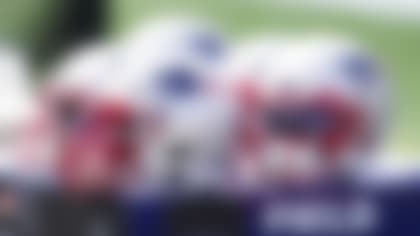The NFL and NFL Players Association held a press call to release the results of their annual helmet laboratory testing to assess the performance of helmets worn by NFL players. The results of the tests are displayed on a poster and shared with NFL players, in addition to club medical, training, coaching and equipment staffs to help inform equipment choices. For more information, see the 2019 helmet poster.
The following is a transcript of a media call held Friday, April 12, 2019.
SPEAKERS:
- Jeff Miller, NFL Executive Vice President, Health and Safety Initiatives
- Kristy Arbogast, Co-Scientific Director of the Center for Injury Research and Prevention at Children's Hospital of Philadelphia and Professor of Pediatrics at University of Pennsylvania; NFLPA Engineering Consultant,
- Jeff Crandall, Director of the Center for Applied Biomechanics at the University of Virginia; Chairman of the NFL Engineering Committee
NFL/NFLPA HELMET LABORATORY TESTING PERFORMANCE RESULTS: MEDIA CALL
APRIL 12, 2019
Jill Pike: Good morning, everybody. Jill Pike here with the NFL. Thanks for joining us today to announce the results of the annual NFL / NFLPA Helmet Testing Performance Results. On the call this morning we have Jeff Miller, the NFL's Executive Vice President of Health and Safety Initiatives; Dr. Jeff Crandall, who is Director of the Center for Applied Biomechanics at the University of Virginia and the Chairman of the NFL's engineering committee; and Dr. Kristy Arbogast, who is Co Scientific Director at the Center of Injury Research and Prevention at the Children's Hospital of Philadelphia, Professor of Pediatrics at the University of Pennsylvania, and the NFLPA Engineering Consultant. We'll start off today by taking you though some background of the helmet testing and then discuss this year's results and then we'll open it up to questions. The participants on this call should all have in their inboxes the press release which was just sent out and the corresponding poster of this year's helmet testing results. I'll now hand it off to Jeff Miller for a brief overview to kick things off.
Jeff Miller: Thanks, Jill. Good morning, everybody. Thanks for taking the time to join us and I'll turn the call over to Drs. Arbogast and Crandall in a moment. But, let me provide a little bit of background. This is the 5th consecutive year that the NFL and NFLPA have worked together to carry out extensive laboratory testing of various football helmet models, those that were new to the marketplace this year. Let me underline for a second the level of collaboration between us at the League and the Players Association. It has really been an incredibly productive relationship. The work done among our biomechanical experts, represented by Drs. Crandall and Arbogast on the phone, has been first rate from the get-go. The work among our medical staffs from Dr. Mayer on the Players Association side to Dr. Sills on our side has also been hand and glove all the way along. So, it is good work on the health and safety front and the engineering front between the folks at the Players Association and the NFL. I'll turn to those folks in a second.
This year, there were 11 helmet models tested that hadn't been tested previously. Six of those rank among the top ten in our rankings this year and are demonstrated on the poster. We think that this is a really interesting point because it is demonstrating again the vitality and dynamism of the helmet industry and I think that the work that we are doing in conjunction with the Players Association is having an effect on that. The substantial amount of research being performed by Dr. Crandall and Dr. Arbogast in their labs and shared and discussed among engineering experts has led to a level of information sharing with the helmet manufacturers who are then able to actually use that information to produce helmet models that are testing better than ever before. This is obviously working to the benefit of our players on-field in real time.
None of the 11 that were tested this year are going to be added to the list of prohibited helmets. However, those that were on the prohibited list last year remain. So, we grandfathered a number of players who wore those helmets last year into one more year of wearing those prohibited helmets. But, that year is now past and into 2019, no player who was previously grandfathered will be permitted to wear one of those helmets in 2019. Today we are sending out to our clubs the new poster along with a number of supporting memos and documents describing the testing, describing what new helmets were being tested and how they performed, and importantly working in conjunction with the Players Association, we're continuing a very strong effort to educate the players, the equipment managers, our coaching and medical staff to help the players make more informed helmet choices. We'll talk a little more about that towards the end of the call. But, for now let me turn it over to Drs. Crandall and Arbogast to give a little background on the testing itself.
Dr. Jeff Crandall: Ok, I think I am going to start here. Dr. Arbogast and I are going to sort of tag team on the poster as well as the testing. So, I'll walk you through the methodology in testing and then she'll walk you through some details on the poster. As Jeff just mentioned, this is our 5th year of doing the NFL and NFLPA laboratory testing. The testing is really designed to evaluate how helmets manage the forces during impact at severities representative of those that we're studying on-field that cause concussions. The testing is performed in an independent laboratory, Biokinetics in Ottawa, Canada – where they have an impactor that is able to apply forces and motions comparable to those a player would experience or apply on-field during an impact.
The helmets are placed on a surrogate head form, which is essentially a crash test dummy head and there is a neck associated with it, intended to represent the human head-neck response during an impact. This response is important because we want to look at one force called linear or translational motion as well as rotational. So, we instrument the dummy with sensors in the head and they measure the acceleration, these linear and rotational accelerations, as well as rotational velocities. The reason the rotational components are important is because there is sort of a growing consensus among biomechanical experts in our field and medical experts that concussions have a component of their injury that is caused by these rotational motions of the head. So, what we do is we measure the accelerations and velocities and then we test over eight different locations, three different speeds for each helmet and then we come up with an aggregate measure that we call a helmet performance score and that's what we use to actually put the helmets on the poster and look at the rankings. Now Kristy is going to walk you through the exact outline of the poster and the rankings.
Dr. Kristy Arbogast: Thanks, Dr. Crandall. We start with the metric that we get from the testing methods and use a statistical test to group helmets with similar performance scores and helmets that are outside that particular grouping are considered significantly different from the top performing group. So, if you look at the helmets on the poster, they are listed in rank order based on their performance score and the top performing group shown in green is a group of helmets whose performance is not statistically different from the top three ranked helmets. As we did last year, the poster this year is again color coded into green, yellow and red. Top performing helmets are shown in a gradient of green where darker green helmets performed better in the laboratory than the lighter green helmets. Helmets in yellow performed worse than the green helmets. And then, those helmets at the bottom of the poster, shown in red, are the group of prohibited helmets based on their testing results from last year.
Two additional things to point out: first is the gradient of the green section which shows how helmets within the top performing group performed, and then second, helmets that are shown in grey text on the poster were worn by less than 1% of players. This distinction is intended to really offer players more information about their helmet decision. The last piece I want to highlight, and I think this is a really important piece, is we've been able to show that analysis of on-field injury rates by helmet model supports the findings observed in the laboratory tests. I think that piece gives us conformation that the testing methods, the impact directions, the impact velocities that we are studying the laboratory correlate to the on-field experience. I think that is the summary of what we have on the poster this year.
Miller: Great, thank you Dr. Arbogast, Dr. Crandall. Let me pick it up here with that last point Dr. Arbogast raised which is information that correlated the testing in the laboratory to the on-field injury rate of players who are wearing particular helmets. Going back to last year, we shared this information with our team medical staffs, equipment staffs, coaching staffs, and certainly most importantly, the players. I think it's that level of information that we were able to provide to the players that helped move a significant number of them from poorly performing in the laboratory helmet to those that were better performing. And so, the statistics that go along with that is about half of the League last year moved to better performing helmets. By week 17 of last season, 74% of the entire League was wearing a helmet that tested into the green or best performing category. That is an increase. That 74% represents an increase of one-third of the entire League over the beginning of the season. We think that is a substantial improvement. We think that there is a savings there for the players on the health and safety side that they were better protected because they were wearing better protective equipment. We believe that it was a collaborative effort with all of the different people that we mentioned – obviously the Players Association but, likewise our equipment staff, our medical staff, our coaching staff, all the way through our organizations and the Players Association through the player representatives and the players themselves to make those changes through the course of the year. So, getting to the place where 74% of the players are wearing the top performing helmets, we think was a significant success.
But, we also believe that there's a lot more work to do. The other 26% of the league, who in Week 17 were either wearing yellow performing helmets or red performing helmets are a priority for us this season to encourage those players to move to the green or the best performing helmets. And we are going to get working on that right away. I mentioned that we sent this poster and the accompanying materials to the clubs today. We also sent each club a list of their players who are wearing a helmet that ranked in red or ranked in yellow. So that we can have targeted discussions with those players about their helmet choice. And what's great about some of the new helmets this year, there are very similar helmets to models that were in the yellow this year that now tested in the green because of improvements that that manufacturers made. So hopefully there will be good choices for players as they look to move from one helmet model to the next.
So, I think that about covers it. Jill, do we want to open it up for questions?
Pike: Yes, so first, thanks to all of our speakers, I appreciate you all taking the time. We do now have time for a Q&A.
Question: Jeff, I wonder, you say 74% of the players were wearing the top performing helmets by Week 17. So, how many then were wearing helmets that you would consider to be in the yellow, that were approved but not among the top performers? And how many were not wearing helmets either in the green or the yellow?
Miller: Ok, so 26% of the league by Week 17 of last year were in either yellow or red. 32 players were still wearing red helmets, the ones that are now prohibited. So, rough math, that is about 2% of the league, or nearly 2% of the league, I believe. So, let's say 24% in yellow and approximately 2% in red.
Question: Have you made any progress so far on those 32?
Miller: We have a plan with the Players Association. They are going to reach out to the players on an individual basis. We at the League are working through our equipment managers. We've met with all of them already individually to share with them the results of the poster as well as the players in their locker rooms and the helmets that they were wearing and those that we are targeting. And obviously we will be re-doubling those efforts this spring, which may include club visits, which are certainly going to include further conversations with the equipment staff, coaching staff, medical staff. But, I think between us and the Players Association it is going to be a constructive one and given the fact that there are so many new helmet models this year, that players are going to have choices, maybe more choices than in previous seasons for helmets that most resemble their own. We are hoping that this transition is going to be, I want to say an easy one but, an acceptable one for those that we want to move to some of the better performing helmets.
Question: Good morning. Since there is no grandfather period anymore, what happens to the players who are still reluctant to change? Are there penalties in place or are you confident that you'll be able to move all of them? And also, do they have to be out of the red performing helmets by the start of the season or can that be an evolution throughout the season?
Miller: It will be by the start of the season. And then to the first question, we are confident. And I think the confidence is based on the really collaborative work with the Players Association who is reaching out, as I mentioned, to each of those 32 players currently, just as we are reaching out to all of the other folks in the organization to make it happen and to make the choices available to those players. The bottom line is that the prohibited helmets will not be allowed in the locker room. A player will not be allowed on the field in a prohibited helmet and the club equipment managers have been directed to remove prohibited helmets from use by the players. Failure to do so is a violation of the policy and if it is determined that a club was aware that one of its players was wearing a prohibited helmet, or the club facilitated the player to wear a prohibited helmet, that club will be subject to discipline from the League.
Question: I assume you guys had some level of dialogue, to this point already, with the players who were in the lower performing helmets last season and now need to switch? If you have had any of those conversations, what do they give as the reason for why they stayed in those helmets? Was it just force of habit? Comfort? What do you sort of need to overcome to get them to switch?
Miller: Well, I wouldn't put my voice in place of the representatives from the Players Association who are having those discussions, nor the equipment managers and the medical staff and the training staff who are having those conversations. But, what has gotten back to me from the team administration staff is that players are looking for options and somebody who wears a helmet for a long period of time has an attachment to that helmet model and that is something that we respect, certainly. But, given the level of scientific data and rigor and work that has gone into doing these analyses and giving the players, hopefully, significant education about helmet testing and about opportunities to switch, we think that will override those considerations. And, look, last year it did. We started last year with 17% of the League with players that were grandfathered into helmets. They had one year to wear them. In other words, let me put it more simply, 17% of the league were in red helmets. At the end of the year, it was 32 guys. So, a lot of the players very easily took to the education, and credit to them and everybody else involved in the process. Likewise, the number of players who moved into green performing helmets, one-third of the league moved last year into green performing helmets. It went from 41% of the league to 74% of the league. So, the education process was thorough. And the players were listening. And the data provided them, as a result of the work done by our engineering group, I think was really persuasive. So, it was substantial improvement last year. We think that working with the other 32 players to get them to a better place is something that is imminently doable and the options available to them are going to help them make those choices.
And I don't know if Kristy or Jeff want to elaborate on the point about different types of helmets that are available, if that is useful, because I am happy to defer to the engineers on that.
Dr. Arbogast: Yeah, I can add something to that. I think we heard comfort, fit and look are reasons that a particular player has an affinity to a helmet. And it is for those reasons that we, this year, for those helmets in the prohibited and yellow category, tried to identify a companion helmet that had a similar comfort, fit and look. Again, providing more information to the players to help them make that decision. Rather than just saying, 'no you can't wear this,' but, adding that extra piece of, 'here is another helmet that may give you that feel that you are comfortable with that is shown in the laboratory to have better performance.' And I think those messages are really resonating with the players as demonstrated by the statistics that Jeff highlighted.
# # #









